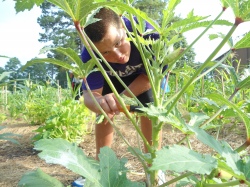Grist: What happens to school gardens in the summer?
Service members Katy Brantley and Dana Stevens share how they keep awesome school garden programming going all summer long.
Service members Katy Brantley and Dana Stevens share how they keep awesome school garden programming going all summer long.

by Claire Thompson
The biggest irony of the school garden is that it often goes untended during summer, the peak season. This is no coincidence; what we now call “summer vacation” used to be the time when most parents needed their children at home in the fields, planting and harvesting.
Now that the majority of Americans are no longer farmers, however, schools have become many children’s sole exposure to agriculture. But the good news is that they’re far from scarce; schools across the country are scrambling to set up food-producing gardens and take advantage of the hands-on lessons they provide.
Alice Waters’ “edible schoolyard,” while no longer considered revolutionary, is still a model for many teachers. FoodCorps, a branch of the AmeriCorps Service Network dedicated to food education, is wrapping up its first year of garden programming in selected schools, and many school districts and nonprofits are embracing school gardens at the local level. But what happens to all these gardens when school’s out for summer?

FoodCorps in the News: 2024

FoodCorps’ Statement on the 2024 Election

FoodCorps Welcomes Rachel Willis as Interim President